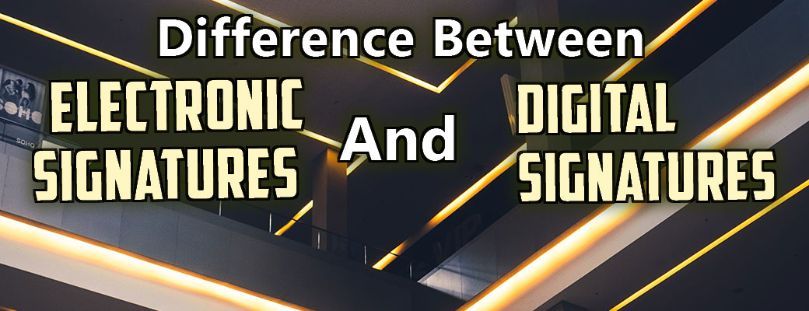Difference Between Electronic Signatures And Digital Signatures

Electronic signatures are much longer than people tend to think, and they are based on new technologies that are helpful in today’s global economy. Although electronic signatures can be as simple as entering a name into an electronic document, digital signatures have been used for many years to implement electronic signatures in a cryptographic way.
Electronic signatures and digital signatures are very similar terms, which leads to a lot of confusion and confusion about the difference between them. So let’s take a further look at how an electronic and a digital signature may vary and what sets them apart.
Electronic Signatures
At its core, an electronic signature doesn’t necessarily have to be a signature. It can include a sound, symbol, or process that’s attached to a contract. They encompass all online signatures and are more broad of a definition than digital signatures.
And even though encryption is not generally used, electronic signatures tend to be more vulnerable to copying and manipulation than digital signatures, because they are more embedded and complex. This is due to the fact that a digital signature does not require any intervention by the computer in use and is subject to random errors.
The other notable aspect that distinguishes an electronic signature from a digital signature is that it can be an electronically signed authorization. This means that digital signatures, which can be expressed either digitally or electronically and linked to a representation of a data set, can be both types of electronic signatures.
Digital Signatures
Digital signatures, on the other hand, refer to solutions for electronic signatures based on encryption and decryption technologies. Digital signatures are often used in circumstances that require a signature for financial transactions or online certificates. They are also more secure because they can be used to authenticate digital documents without the need for a physical copy of the document, such as a paper or digital copy, as they are essentially the online equivalent of a notarized signature.
Although a cosmetic image of a signee’s signature can be placed on a line, digital signatures have all the elements of electronic signatures, except that the validity of the electronic signature is underpinned by a digital signature key encrypted in the document. Sometimes referred to as a cryptographic signature, it is considered the most secure type of electronic signature. Like electronic signatures, digital signatures use an algorithm that acts like a fingerprint, so that a document or signature is protected from manipulation during the signing process. Due to the high level of security and authenticity, they have always been preferred to electronic signatures.
You can also learn more about digital signatures in our previous blog by going here.
Key Differences
The terms electronic signature and digital signature are often used interchangeably, but they are actually different animals. There is often a lot of confusion about the difference between electronic and digital signatures. Notably, electronic signatures include all forms of a signature whereas digital signatures are attached to an actual signature.
One of the biggest drawbacks that can occur, however, is the difference between electronic and digital signatures in terms of security. This crucial difference is what you need to understand when choosing the right product for your company to properly handle your signature. If you are in the market for a signature software, you will want to choose digital signature software that fits your needs and maintains your identity and security.
When it comes to choosing a secure software for signing documents online, you will want to look into a digital signature software that’s complete with security functions to protect your name. One of the best is ArcSign. With ArcSign, you can send documents to be signed to your clients through email or securely sign documents yourself. You can also conceal your signed documents with a password to add protection from someone getting hold of your digital signature. You can learn more by going here to find out more.
And Finally…
While there is typically a lack of understanding between the difference of an electronic signature and a digital signature, hopefully things are a little more clear and it becomes much easier to make a decision about what type of electronic signature software is best suited for your business.
